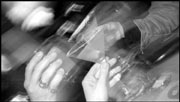MAYBE YOU’RE the type of margarita drinker who thinks of the quintessential tequila cocktail as a carefree, fruity concoction, the kind of thing you drink when you want more than a beer and less than a martini. Or maybe you consider yourself a connoisseur, the type of person who orders things like the “tuna margarita” at Agua Verde or the Cadillac margarita just about anywhere. Hell, maybe you’re a person who enjoys your intoxicants, and a margarita—with two-plus ounces of 80-proof liquor—is about the most alcoholic thing around. But chances are, there’s a lot you don’t know about this most Southwestern of drinks—starting, perhaps, with its mysterious origins.
Unlike, say, a gin and tonic, a margarita is the kind of drink that had to be invented. Naturally, given how drunk it gets you, no one can agree on exactly where this particular combination of citrus, salt, and tequila originated. Some say it was dreamed up by a socialite named Margaret Sames, who wanted to serve something special to her friends; “the Drink,” which featured her favorite liqueur, Cointreau, kept the party going for two weeks. Others claim it was invented in the ’30s by a Tijuana bartender for a customer named Marjorie King, a showgirl who was allergic to all liquor except tequila, which she couldn’t drink straight. Still others think the margarita’s just a spin-off of the sidecar, a sugar-dipped drink made of cognac, lemon juice, and Cointreau—just substitute salt for the sugar and tequila for the cognac.
Whatever—the basic margarita hasn’t changed: lime (or lemon) juice, orange liqueur, and, of course, tequila. Funny how few restaurants manage to get it right. Most margarita mistakes involve adding sugar (a definite no-no—would you add sweetener to a scotch and soda?) or substituting any number of weird, icky ingredients (anything from sweet-and-sour to limeade to 7UP) for the requisite citrus juice. (Many places also use water to dilute your drink—the dirty little secret of the “frozen” margarita.) Bad tequila—the stuff most places pour into margarita machines by the bucket load—is another deadly sin of margarita mixology.
But plenty of places in Seattle do make a decent margarita. My personal favorite—a preference that has nothing to do with its half-block proximity to the Weekly office—is McCormick and Schmick’s (1103 First, 623-5500; also 722 Fourth, 682-3900 and 1200 Westlake N., 270-9052), a noisy happy-hour hot spot where they juice your limes to order and pour their tart, tequila-loaded margaritas “Mexican martini”-style, with a shaker glass and strainer on the side. Equally authentic is the house margarita at El Ni�113 Virginia, 441-5454), where you can also spend a long time drooling over the huge tequila list. Another nice (if not so authentic) margarita can be found at El Gallito (1700 20th, 329-8088), where the sweetish, orangey drink comes in a pint glass (hey, the added sweet-and-sour mix isn’t so bad considering the extra tequila you’re getting), festooned with a cherry and an orange wedge. El Camino (607 N. 35th, 632-7303), a Fremont neuvo-Mex place where the bar is always packed with beautiful people, has a hand-shaken margarita that tastes, quite disarmingly, like tart lemonade (what it doesn’t taste like is alcohol, but rest assured, there’s plenty in there). Columbia City’s Deux Tamales (4868 Rainier S., 725-1418)—and, we presume, its West Seattle sister, Les Tamales (3247 California S.W., 923-3538)—offers a decent rendition, flavored strongly—and almost too sweetly—with Triple Sec.
BUT WHAT IF YOU don’t want to spend upward of six bucks for a drink you could just as easily make at home? Before you fork over your $40 to the Liquor Control Board, here’s a miniprimer on the product you’re about to purchase.
Everything out there calling itself “tequila”—from the cheapest rotgut to the most expensive sipping tequila—must be made from the juice of the cooked heart of the blue agave plant, which in turn can be grown in only five Mexican states. The Mexican government takes this more seriously than most such things; regulators oversee every aspect of distillery, from the farming of the agave plants to the barreling and uncasking of “aged” reposado and a� tequilas.
The first category of tequila—and the least expensive—is silver, or plata, tequila, bottled immediately after distilling. Reposado tequila has “rested” in its fermenting barrels for up to a year and has a slightly more golden hue. A� and muy a� tequilas (old and real old, respectively) have been in barrels for longer still, and are meant to be sipped, not poured into margaritas or slugged. A� tequilas are oaky, like aged brandy or single-malt scotch.
To bust two widely held misconceptions about tequila: There’s no such thing as “gold” tequila—only silver tequila that’s been darkened with artificial coloring. And that stuff you drank in college? With the worm? That’s not tequila—it’s mezcal, a distilled liquor that’s also derived from agave. Believe it or not, good, 100 percent agave tequila (it’ll say so on the label) shouldn’t give you a hangover; that comes mostly from sugar, both the kind that’s added to margaritas and the cane juice sometimes used to cut tequila itself. Work in the morning on seis de mayo will go a little more smoothly if you get the good stuff, so please don’t just go and buy a $13 bottle of Potter’s and a jug of margarita mix. The latter contains so much sugar and artificial goop it tastes like snow-cone syrup, and the former is where the term “to-kill-ya” came from.
WHAT TO BUY
Unless you go in more for prestige than taste, you shouldn’t feel the need to spend more than 40 bucks or so on any bottle of tequila. Good cheaper options include Cuervo Especial (20 bucks for a .75-liter bottle) and Sauza silver ($19). If you’ve got a little more to spend, try El Jimador reposado (around $30) or El Conquistador blanco ($30). Really good tequilas aren’t cheap, but if you really like tequila, they’re well worth it. Some of the best: Chinaco (between 40 and 50 bucks a bottle), El Tesoro (from $35 up to $109), Don Julio ($40-$50), Patron ($47-$54), and Herradura (from $37 for the silver all the way to $300).
THE RECIPE
Once you’ve got your tequila, all you really need is a decent orange liqueur—Triple Sec, Cointreau, or Grand Marnier, although the latter can easily overwhelm a drink—some limes, a shaker, and some cracked ice. If you like salt on the glass, run a lime wedge around the rim and dip the glass into a dish of kosher salt (the chunky kind) before pouring your libation.
Traditional margarita 1 oz. tequila 1 oz. Cointreau or Triple Sec 1 oz. freshly squeezed lime juice Salt
Mix the tequila, lime juice, and Cointreau in a shaker with ice and pour or strain into a salt-dipped margarita or martini glass.
Strawberry margarita 1 oz. tequila 1 oz. Cointreau or triple sec 1 oz. freshly squeezed lime or lemon juice 2 oz. simple syrup 8 fresh strawberries 2 cups cracked ice
Blend!







